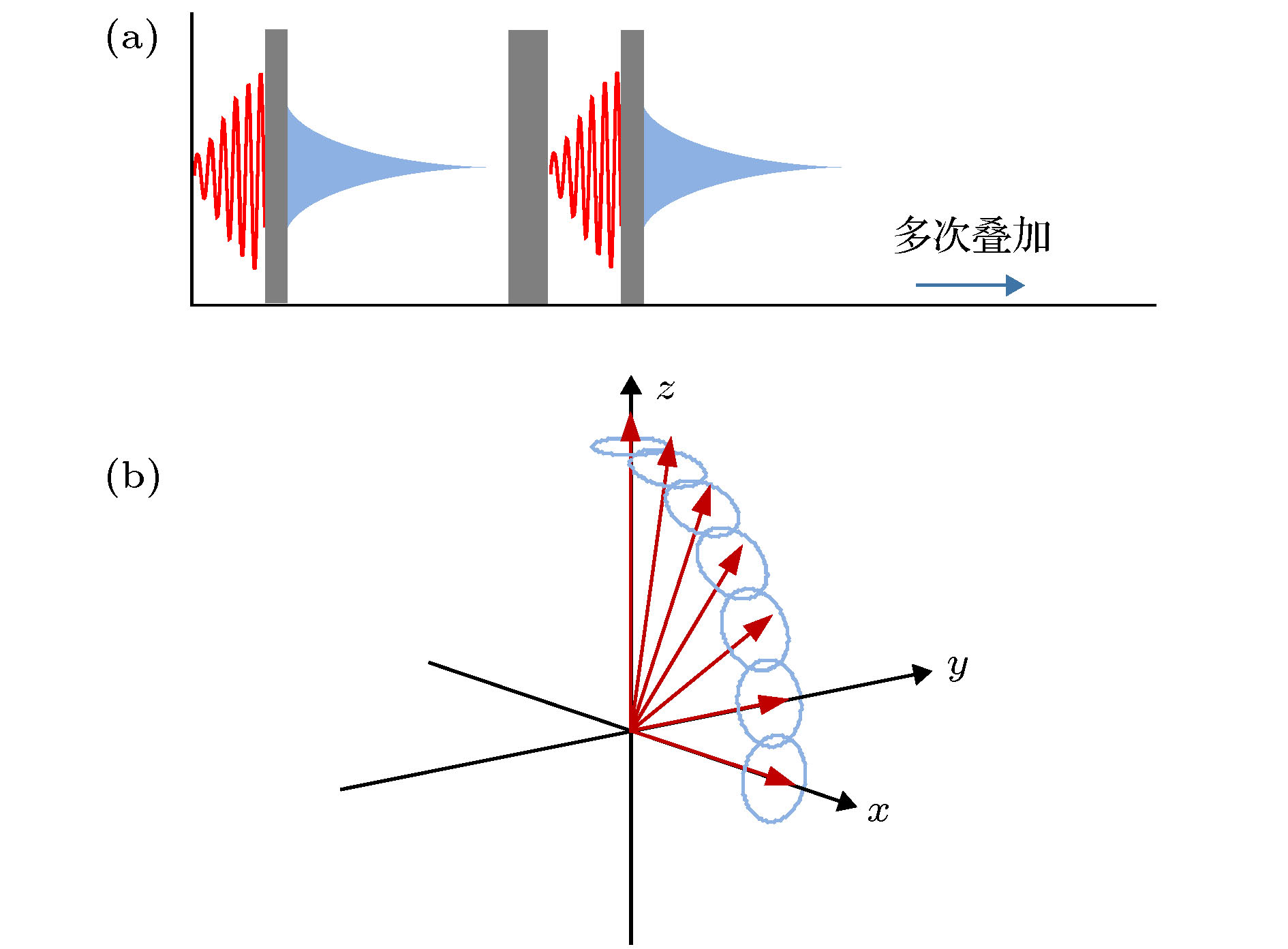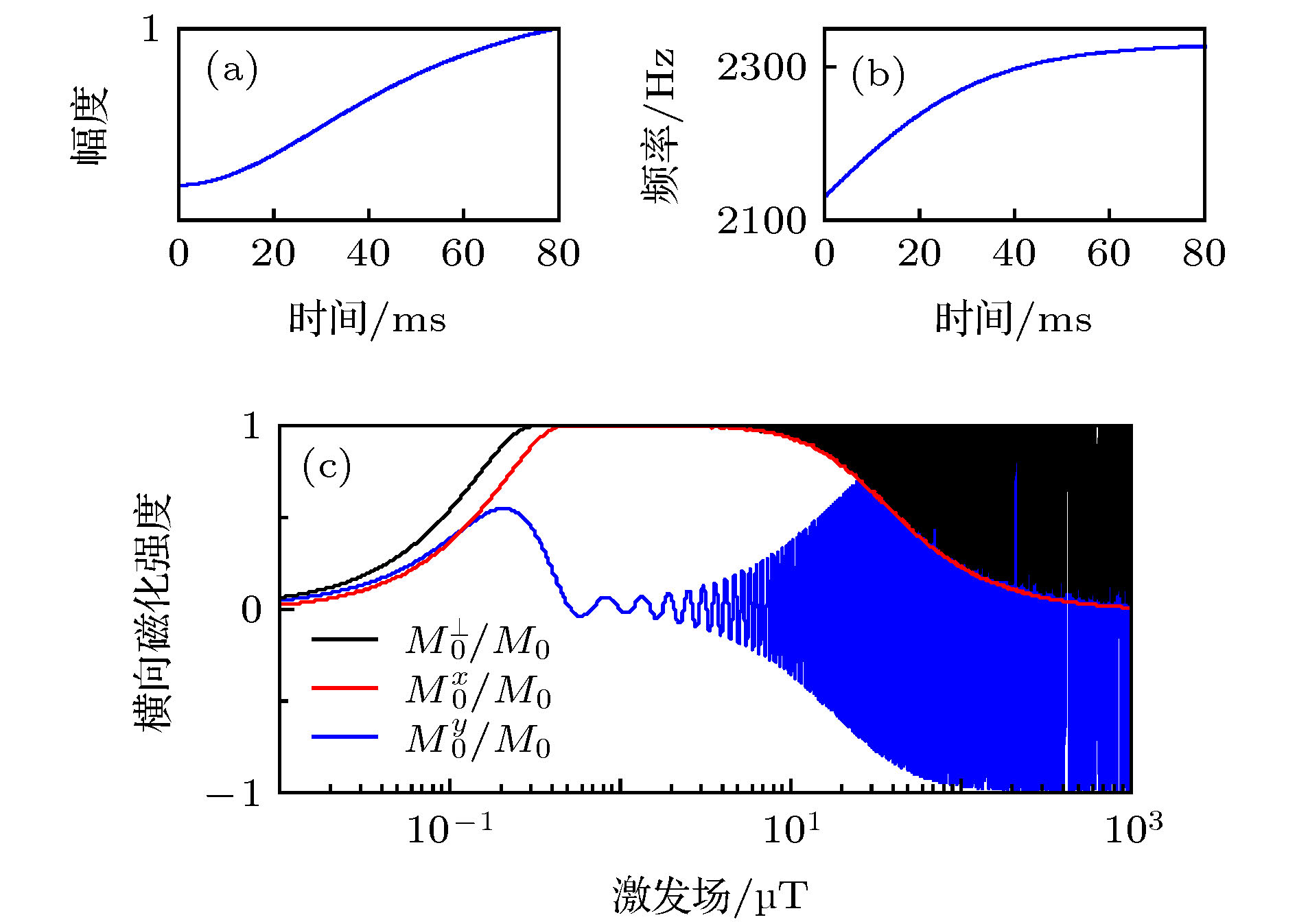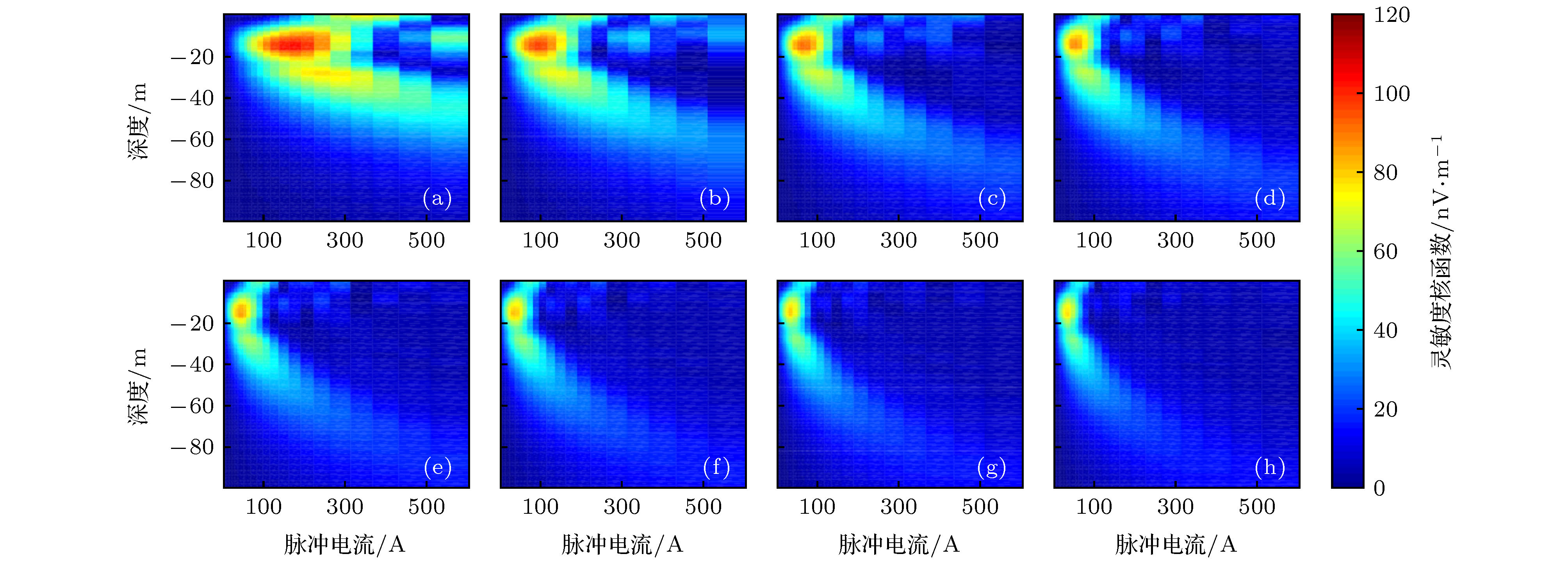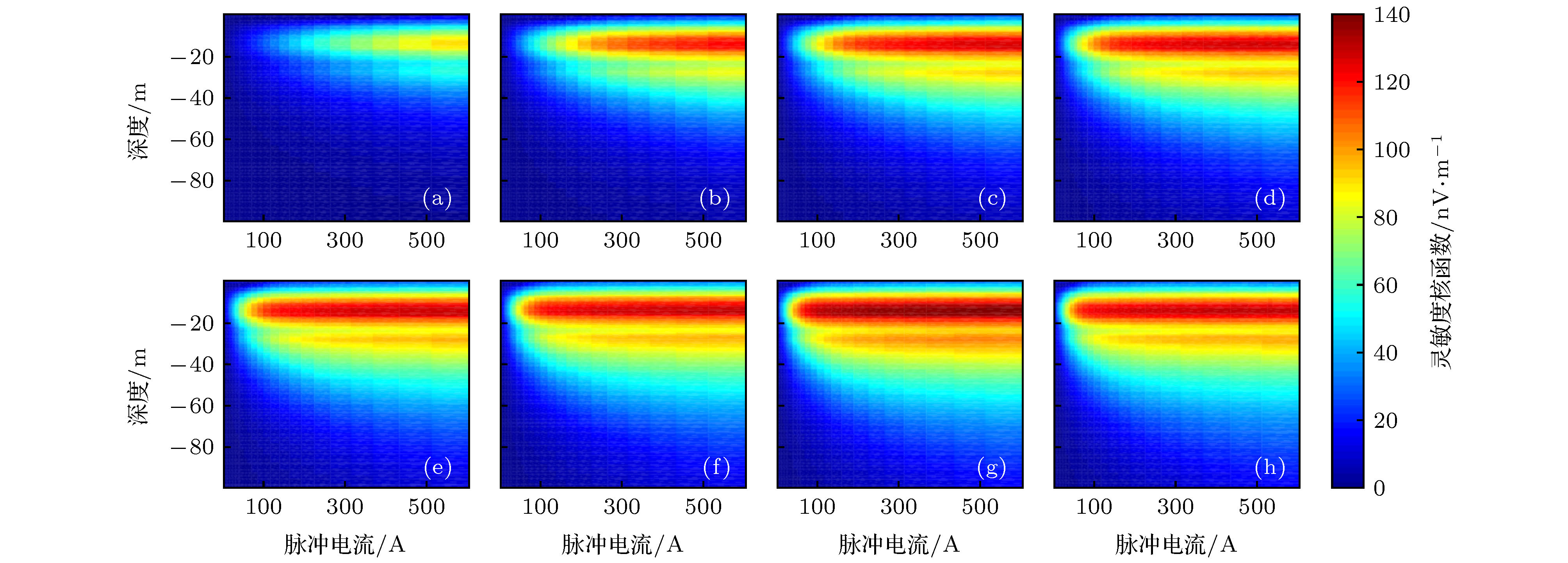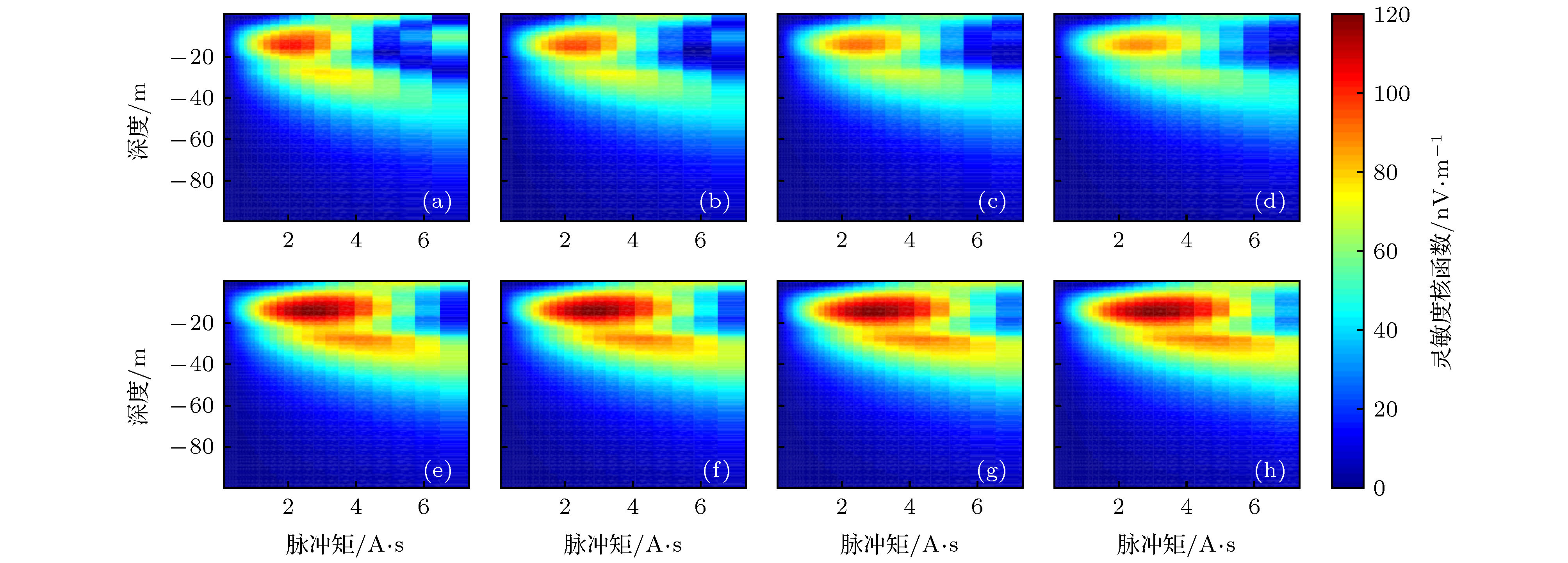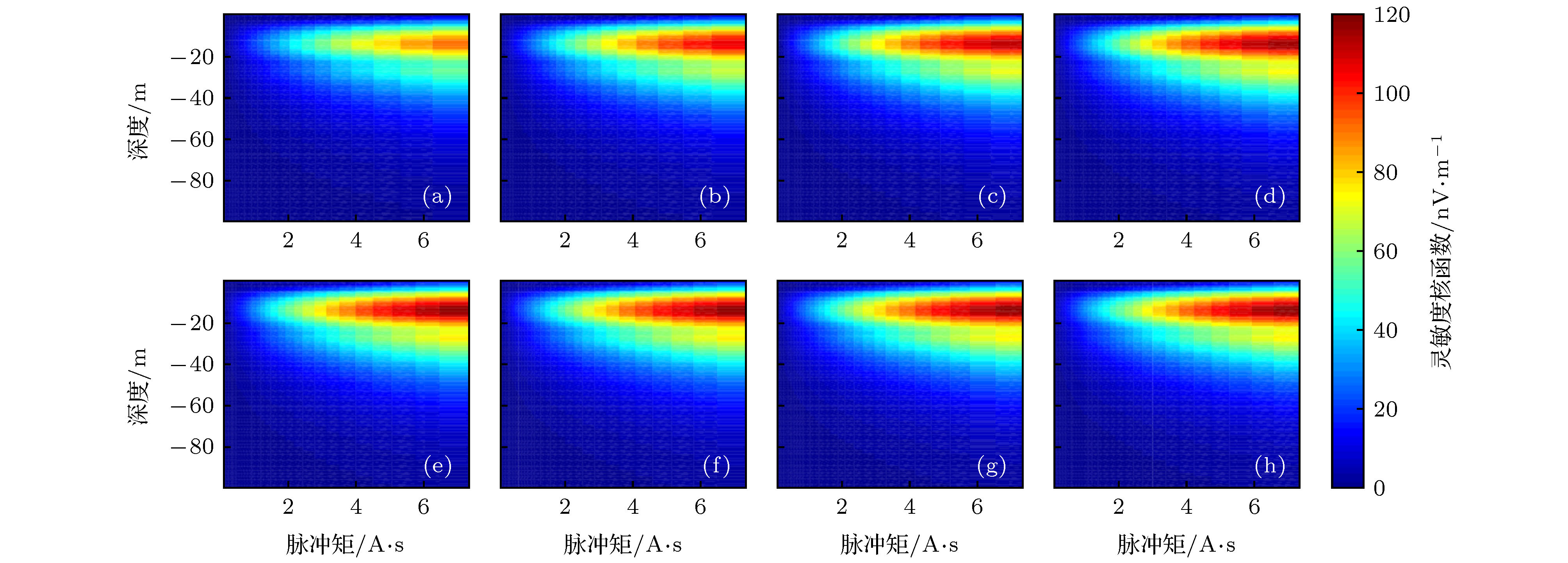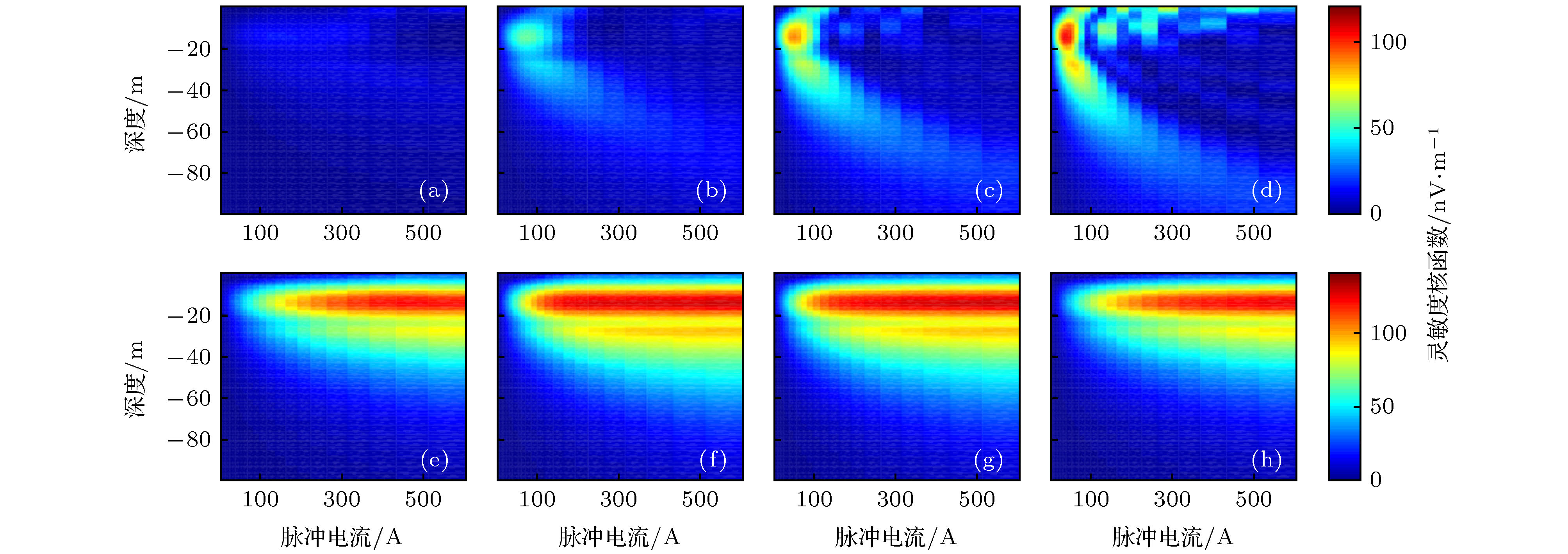-
Magnetic resonance sounding (MRS) technology used to detect groundwater directly and quantificationally, which owns the advantages of rich information and low cost. In these years, it has shown significant potential applications in hydrological detections. Considering the traditional measurements with the geomagnetic field, the nano-valt MRS signals are easy to suppress to environmental noise. As one of the MRS signal enhancement methods, the adiabatic pulse was quite popular recently. It is transmitted with variable frequency and amplitude pulse satisfying the adiabatic condition, which can enhance the signal amplitude and signal-to-noise ratio several times. However, there are only a few reports about this method, especially its geophysical modeling. Thus, we introduce the calculating progress of transverse magnetization and kernel function for this method. By employing the interpolation, the computation cost of forward modeling is obviously reduced. Moreover, several different settings of adiabatic transmitting factors are also proceeded to obtain certain results. In conclusion, a pulse moment with 80 ms transmitting duration and 30 quality factor produces a maximum signal amplitude that is enhanced 16.56 times for deep areas. The research in this paper could provide powerful support for MRS method used in noisy environments.
[1] 吴璐苹, 石昆法, 李荫槐, 李松浩 1996 地球 39 712
 Google Scholar
Google Scholar
Wu L P, Shi K F, Li Y H, Li S H 1996 Chin. J. Geophys. 39 712
 Google Scholar
Google Scholar
[2] Di Q Y, Xue G Q, Fu C M, Wang R 2020 Sci. Bull. 65 611
 Google Scholar
Google Scholar
[3] Di Q Y, Wang M Y 2010 Bull. Eng. Geol. Environ. 69 105
 Google Scholar
Google Scholar
[4] Di Q Y, Xue G Q, Lei D, Wang Z X, Zhang Y M, Wang S, Zhang Q M 2018 J. Appl. Geophys. 158 65
 Google Scholar
Google Scholar
[5] 侯彦威 2012 地球物理学进展 27 2698
 Google Scholar
Google Scholar
Hou Y W 2012 Prog. Geophys. 27 2698
 Google Scholar
Google Scholar
[6] 傅良魁, 孟海东, 宋宇辰 1993 物探与化探 6 435
Fu L K, Meng H D, Song Y C 1993 Geophys. Geochem. Explor. 6 435
[7] Behroozmand A A, Keating K, Auken E 2015 Surv. Geophys. 36 27
 Google Scholar
Google Scholar
[8] 林君, 段清明, 王应吉 2010 核磁共振找水仪原理与应用 (北京: 科学出版社) 第7—13页
Lin J, Duan Q M, Wang Y J 2010 Theory and Design of Magnetic Resonance Sounding Instrument for Groundwater Detection and Its Applications (Beijing: Science Press) pp7-13 (in Chinese)
[9] Hertrich M, Braun M, Gunther T 2007 IEEE Trans. Geosci. Remote Sens. 45 3752
 Google Scholar
Google Scholar
[10] 潘玉玲, 张昌达 2000 地面核磁共振找水理论和方法 (北京: 中国地质大学出版社) 第1—5页
Pan Y L, Zhang C D 2000 Theory and Method of Surface Nuclear Magnetic Resonance Instrument for Groundwater Detection (Beijing: China University of Geosciences Press) pp1-5 (in Chinese)
[11] 孙淑琴, 林君, 张庆文, 嵇艳鞠 2005 物探与化探 29 153
 Google Scholar
Google Scholar
Sun S Q, Lin J, Zhang Q W, Ji Y J 2005 Geophys. Geochem. Explor. 29 153
 Google Scholar
Google Scholar
[12] Davis A C, Dlugosch R, Queitsch M, Macnae J C, Stolz R, Mueller-Petke M 2014 Geophys. Res. Lett. 41 4222
 Google Scholar
Google Scholar
[13] Lin T T, Zhang Y, Lee Y H, Krause H J, Lin J 2014 Rev. Sci. Instrum. 85 114708
 Google Scholar
Google Scholar
[14] Jiang C D, Lin J, Duan Q M, Sun S Q, Tian B F 2011 Near Surf. Geophys. 9 459
 Google Scholar
Google Scholar
[15] Costabel S, Mueller-Petke M 2014 Near Surf. Geophys. 12 185
 Google Scholar
Google Scholar
[16] Larsen J J 2016 Geophysics 81 WB1
 Google Scholar
Google Scholar
[17] Legchenko A, Valla P 2003 J. Appl. Geophys. 53 103
 Google Scholar
Google Scholar
[18] Larsen J J, Dalgaard E, Auken E 2014 Geophys. J. Int. 196 828
 Google Scholar
Google Scholar
[19] Walsh D O 2008 J. Appl. Geophys. 66 140
 Google Scholar
Google Scholar
[20] Mueller-Petke M, Costabel S 2014 Near Surf. Geophys. 12 199
 Google Scholar
Google Scholar
[21] Lin T T, Zhang Y, Yi X F, Fan T H, Wan L 2018 Geophys. J. Int. 213 727
 Google Scholar
Google Scholar
[22] 林婷婷, 张扬, 杨莹, 杨莹, 滕飞, 万玲 2018 地球 61 3812
 Google Scholar
Google Scholar
Lin T T, Zhang Y, Yang Y, Yang Y J, Teng F, Wan L 2018 Chin. J. Geophys. 61 3812
 Google Scholar
Google Scholar
[23] Grombacher D, Knight R 2015 Geophysics 80 E329
 Google Scholar
Google Scholar
[24] Lin T T, Yang Y J, Teng F, Wan L 2017 Geophys. J. Int. 212 1463
 Google Scholar
Google Scholar
[25] Grunewald E, Grombacher D, Walsh D 2016 Geophysics 81 WB85
 Google Scholar
Google Scholar
[26] Tannus A, Garwood M 1997 NMR Biomed. 10 423
 Google Scholar
Google Scholar
[27] Garwood M, DelaBarre L 2002 J. Magn. Reson. 153 155
 Google Scholar
Google Scholar
[28] Wi S, Kim C, Schurko R, Frydman L 2017 J. Magn. Reson. 277 131
 Google Scholar
Google Scholar
[29] Levitt M H 2002 Spin Dynamics-Basics of Nuclear Magnetic Resonance (Chichester: John Wiley & Sons, LTD) pp1–6
[30] Callaghan P 2007 Principles of Nuclear Magnetic Resonance Microscopy (New Zealand: Oxford University Press) pp1–8
[31] Hertrich M 2008 Prog. Nucl. Magn. Reson. Spectrosc. 53 227
 Google Scholar
Google Scholar
[32] Weichman P B, Lavely E M, Ritzwoller M H 2000 Phys. Rev. E 62 1290
 Google Scholar
Google Scholar
[33] Walbrecker J O, Hertrich M, Green A G 2011 Geophysics 76 G1
 Google Scholar
Google Scholar
[34] Grombacher D, Walbrecker J O, Knight R 2014 Geophysics 79 E329
 Google Scholar
Google Scholar
[35] Bloch F 1946 Phys. Rev. 70 460
 Google Scholar
Google Scholar
[36] Baum J, Tycko R, Pines A 1985 Phys. Rev. A 32 3435
 Google Scholar
Google Scholar
[37] Behroozmand A A, Auken E, Fiandaca G, Rejkjaer S 2016 Geophys. J. Int. 205 243
 Google Scholar
Google Scholar
-
图 2 绝热磁共振激发过程 (a) 发射时序, 红色曲线为发射电流, 蓝色曲线为FID信号; (b) 激发磁场与磁化强度示意图, 深红箭头和蓝色线分别表示激发磁场与磁化强度
Figure 2. Excitation process of the adiabatic pulses: (a) The sequence diagram of the transmitting current (red) and FID signal (blue); (b) the relationship of the excitation magnetic field (dark red arrow) and magnetization (blue line).
图 3 双曲正切绝热半波横向磁化强度与有效激发磁场关系图(品质因数Q = 30, 脉冲持续时间τ = 80 ms) (a)发射波形实时幅值; (b)频率调制函数; (c)磁化强度x分量、y分量及模值
Figure 3. The relationship of transverse magnetization and exciting magnetic based on hyperbolic tangent AHP pulse: (a) The waveform of transmitting current amplitude; (b) its frequency vs. time; (c) magnetization x-component, y-component and real value.
图 4 相同激发电流分布(1—600 A)情况下, 脉冲持续时间τ不同时, 绝热半波对应的灵敏度核函数实部(品质因数Q = 30) (a) τ = 20 ms; (b) τ = 40 ms; (c) τ = 60 ms; (d) τ = 80 ms; (e) τ = 100 ms; (f) τ = 120 ms; (g) τ = 140 ms; (h) τ = 160 ms
Figure 4. The real kernel function of adiabatic half-passage pulses for the same excitation current (1–600 A) corresponding to different τ, with quality factor Q = 30: (a) τ = 20 ms; (b) τ = 40 ms; (c) τ = 60 ms; (d) τ = 80 ms; (e) τ = 100 ms; (f) τ = 120 ms; (g) τ = 140 ms; (h) τ = 160 ms.
图 5 相同激发电流分布情况下, 脉冲持续时间τ不同时绝热半波对应的灵敏度核函数虚部(品质因数Q = 30) (a) τ = 20 ms; (b) τ = 40 ms; (c) τ = 60 ms; (d) τ = 80 ms; (e) τ = 100 ms; (f) τ = 120 ms; (g) τ = 140 ms; (h) τ = 160 ms
Figure 5. The imaginary kernel function of adiabatic half-passage pulses for the same excitation current (1–600 A) corresponding to different τ, with quality factor Q = 30: (a) τ = 20 ms; (b) τ = 40 ms; (c) τ = 60 ms; (d) τ = 80 ms; (e) τ = 100 ms; (f) τ = 120 ms; (g) τ = 140 ms; (h) τ = 160 ms.
图 6 相同脉冲矩(0.01—7.3 A·s)情况下, 脉冲持续时间τ不同时绝热半波对应的灵敏度核函数实部(品质因数Q = 30) (a) τ = 20 ms, 最大600 A电流; (b) τ = 40 ms, 最大300 A电流; (c) τ = 60 ms, 最大200 A电流; (d) τ = 80 ms, 最大150 A电流; (e) τ = 100 ms, 最大120 A电流; (f) τ = 120 ms, 最大100 A电流; (g) τ = 140 ms, 最大85.7 A电流; (h) τ = 160 ms, 最大75 A电流
Figure 6. The real kernel function of adiabatic half-passage pulses for the same pulse moment corresponding to different τ, with quality factor Q = 30: (a) τ = 20 ms with maximum current 600 A; (b) τ = 40 ms with maximum current 300 A; (c) τ = 60 ms with maximum current 200 A; (d) τ = 80 ms with maximum current 150 A; (e) τ = 100 ms with maximum current 120 A; (f) τ = 120 ms with maximum current 100 A; (g) τ = 140 ms with maximum current 85.7 A; (h) τ = 160 ms with maximum current 75 A.
图 7 相同脉冲矩(0.01—7.3 A.s)情况下, 脉冲持续时间τ不同时绝热半波对应的灵敏度核函数虚部(品质因数Q = 30) (a) τ = 20 ms, 最大600 A电流; (b) τ = 40 ms, 最大300 A电流; (c) τ = 60 ms, 最大200 A电流; (d) τ = 80 ms, 最大150 A电流; (e) τ = 100 ms, 最大120 A电流; (f) τ = 120 ms, 最大100 A电流; (g) τ = 140 ms, 最大85.7 A电流; (h) τ = 160 ms, 最大75 A电流
Figure 7. The imaginary kernel function of adiabatic half-passage pulses for the same pulse moment corresponding to different τ, with quality factor Q = 30: (a) τ = 20 ms with maximum current 600 A; (b) τ = 40 ms with maximum current 300 A; (c) τ = 60 ms with maximum current 200 A; (d) τ = 80 ms with maximum current 150 A; (e) τ = 100 ms with maximum current 120 A; (f) τ = 120 ms with maximum current 100 A; (g) τ = 140 ms with maximum current 85.7 A; (h) τ = 160 ms with maximum current 75 A.
图 8 相同脉冲矩(0.01—7.3 A·s)情况下, 在不同脉冲持续时间及电流条件时绝热半波对应的正演响应(假设地下半空间内存在10%均匀的含水量, 发射线圈的品质因数Q = 30)
Figure 8. The forward modeling of adiabatic half-passage pulse for the same pulse moment (0.01–7.3 A·s) with different τ and current. The modeling assume a homogeneous aquifer subsurface with 10% water content, the quality factor Q = 30.
图 9 脉冲持续时间τ = 80 ms, 品质因数Q不同时绝热半波对应的灵敏度核函数的(a), (b), (c), (d)实部和(e), (f), (g), (h)虚部 (a), (e) Q = 10; (b), (f) Q = 20; (c), (g) Q = 30; (d), (h) Q = 40
Figure 9. The (a), (b), (c), (d) real and (e), (f), (g), (h) imaginary part of the kernel function of adiabatic half-passage pulses for different quality factor Q with τ = 80 ms: (a), (e) Q = 10; (b), (f) Q = 20; (c), (g) Q = 30; (d), (h) Q = 40.
图 10 相同绝热脉冲电流(1—600 A)条件下, 品质因数Q不同时绝热半波对应的正演响应(灰色虚线为传统激发方式信号响应, 假设地下半空间内存在10%均匀的含水量, 发射脉冲持续时间为80 ms)
Figure 10. The forward modeling of adiabatic half-passage pulse for the same pulse current (1–600 A) with different quality factor Q (The gray dotted line is the initial amplitude of traditional nuclear magnetic resonance responses). The modeling assume a homogeneous aquifer subsurface with 10% water content with τ = 80 ms.
-
[1] 吴璐苹, 石昆法, 李荫槐, 李松浩 1996 地球 39 712
 Google Scholar
Google Scholar
Wu L P, Shi K F, Li Y H, Li S H 1996 Chin. J. Geophys. 39 712
 Google Scholar
Google Scholar
[2] Di Q Y, Xue G Q, Fu C M, Wang R 2020 Sci. Bull. 65 611
 Google Scholar
Google Scholar
[3] Di Q Y, Wang M Y 2010 Bull. Eng. Geol. Environ. 69 105
 Google Scholar
Google Scholar
[4] Di Q Y, Xue G Q, Lei D, Wang Z X, Zhang Y M, Wang S, Zhang Q M 2018 J. Appl. Geophys. 158 65
 Google Scholar
Google Scholar
[5] 侯彦威 2012 地球物理学进展 27 2698
 Google Scholar
Google Scholar
Hou Y W 2012 Prog. Geophys. 27 2698
 Google Scholar
Google Scholar
[6] 傅良魁, 孟海东, 宋宇辰 1993 物探与化探 6 435
Fu L K, Meng H D, Song Y C 1993 Geophys. Geochem. Explor. 6 435
[7] Behroozmand A A, Keating K, Auken E 2015 Surv. Geophys. 36 27
 Google Scholar
Google Scholar
[8] 林君, 段清明, 王应吉 2010 核磁共振找水仪原理与应用 (北京: 科学出版社) 第7—13页
Lin J, Duan Q M, Wang Y J 2010 Theory and Design of Magnetic Resonance Sounding Instrument for Groundwater Detection and Its Applications (Beijing: Science Press) pp7-13 (in Chinese)
[9] Hertrich M, Braun M, Gunther T 2007 IEEE Trans. Geosci. Remote Sens. 45 3752
 Google Scholar
Google Scholar
[10] 潘玉玲, 张昌达 2000 地面核磁共振找水理论和方法 (北京: 中国地质大学出版社) 第1—5页
Pan Y L, Zhang C D 2000 Theory and Method of Surface Nuclear Magnetic Resonance Instrument for Groundwater Detection (Beijing: China University of Geosciences Press) pp1-5 (in Chinese)
[11] 孙淑琴, 林君, 张庆文, 嵇艳鞠 2005 物探与化探 29 153
 Google Scholar
Google Scholar
Sun S Q, Lin J, Zhang Q W, Ji Y J 2005 Geophys. Geochem. Explor. 29 153
 Google Scholar
Google Scholar
[12] Davis A C, Dlugosch R, Queitsch M, Macnae J C, Stolz R, Mueller-Petke M 2014 Geophys. Res. Lett. 41 4222
 Google Scholar
Google Scholar
[13] Lin T T, Zhang Y, Lee Y H, Krause H J, Lin J 2014 Rev. Sci. Instrum. 85 114708
 Google Scholar
Google Scholar
[14] Jiang C D, Lin J, Duan Q M, Sun S Q, Tian B F 2011 Near Surf. Geophys. 9 459
 Google Scholar
Google Scholar
[15] Costabel S, Mueller-Petke M 2014 Near Surf. Geophys. 12 185
 Google Scholar
Google Scholar
[16] Larsen J J 2016 Geophysics 81 WB1
 Google Scholar
Google Scholar
[17] Legchenko A, Valla P 2003 J. Appl. Geophys. 53 103
 Google Scholar
Google Scholar
[18] Larsen J J, Dalgaard E, Auken E 2014 Geophys. J. Int. 196 828
 Google Scholar
Google Scholar
[19] Walsh D O 2008 J. Appl. Geophys. 66 140
 Google Scholar
Google Scholar
[20] Mueller-Petke M, Costabel S 2014 Near Surf. Geophys. 12 199
 Google Scholar
Google Scholar
[21] Lin T T, Zhang Y, Yi X F, Fan T H, Wan L 2018 Geophys. J. Int. 213 727
 Google Scholar
Google Scholar
[22] 林婷婷, 张扬, 杨莹, 杨莹, 滕飞, 万玲 2018 地球 61 3812
 Google Scholar
Google Scholar
Lin T T, Zhang Y, Yang Y, Yang Y J, Teng F, Wan L 2018 Chin. J. Geophys. 61 3812
 Google Scholar
Google Scholar
[23] Grombacher D, Knight R 2015 Geophysics 80 E329
 Google Scholar
Google Scholar
[24] Lin T T, Yang Y J, Teng F, Wan L 2017 Geophys. J. Int. 212 1463
 Google Scholar
Google Scholar
[25] Grunewald E, Grombacher D, Walsh D 2016 Geophysics 81 WB85
 Google Scholar
Google Scholar
[26] Tannus A, Garwood M 1997 NMR Biomed. 10 423
 Google Scholar
Google Scholar
[27] Garwood M, DelaBarre L 2002 J. Magn. Reson. 153 155
 Google Scholar
Google Scholar
[28] Wi S, Kim C, Schurko R, Frydman L 2017 J. Magn. Reson. 277 131
 Google Scholar
Google Scholar
[29] Levitt M H 2002 Spin Dynamics-Basics of Nuclear Magnetic Resonance (Chichester: John Wiley & Sons, LTD) pp1–6
[30] Callaghan P 2007 Principles of Nuclear Magnetic Resonance Microscopy (New Zealand: Oxford University Press) pp1–8
[31] Hertrich M 2008 Prog. Nucl. Magn. Reson. Spectrosc. 53 227
 Google Scholar
Google Scholar
[32] Weichman P B, Lavely E M, Ritzwoller M H 2000 Phys. Rev. E 62 1290
 Google Scholar
Google Scholar
[33] Walbrecker J O, Hertrich M, Green A G 2011 Geophysics 76 G1
 Google Scholar
Google Scholar
[34] Grombacher D, Walbrecker J O, Knight R 2014 Geophysics 79 E329
 Google Scholar
Google Scholar
[35] Bloch F 1946 Phys. Rev. 70 460
 Google Scholar
Google Scholar
[36] Baum J, Tycko R, Pines A 1985 Phys. Rev. A 32 3435
 Google Scholar
Google Scholar
[37] Behroozmand A A, Auken E, Fiandaca G, Rejkjaer S 2016 Geophys. J. Int. 205 243
 Google Scholar
Google Scholar
Catalog
Metrics
- Abstract views: 8710
- PDF Downloads: 89
- Cited By: 0














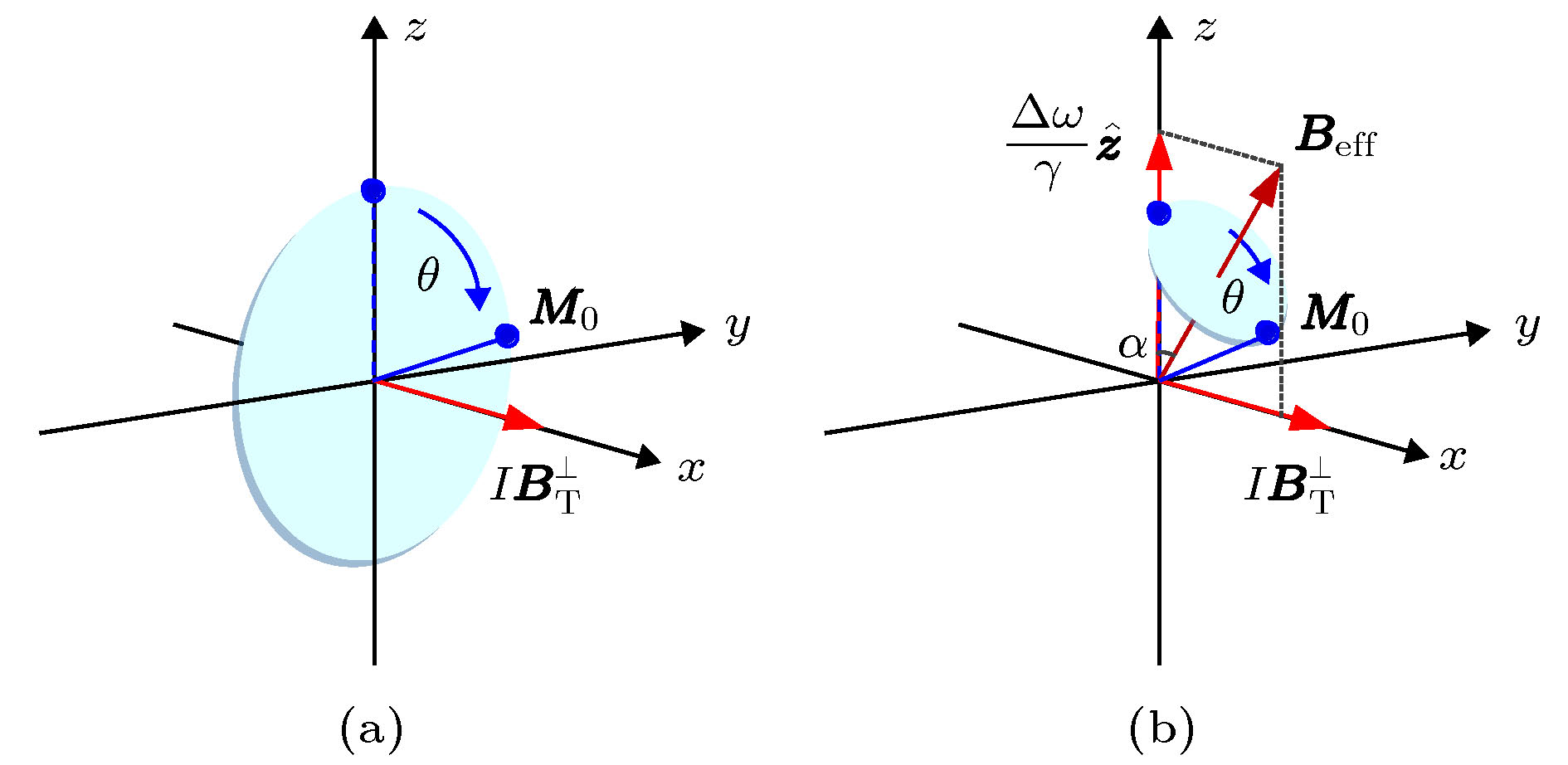
 DownLoad:
DownLoad:
